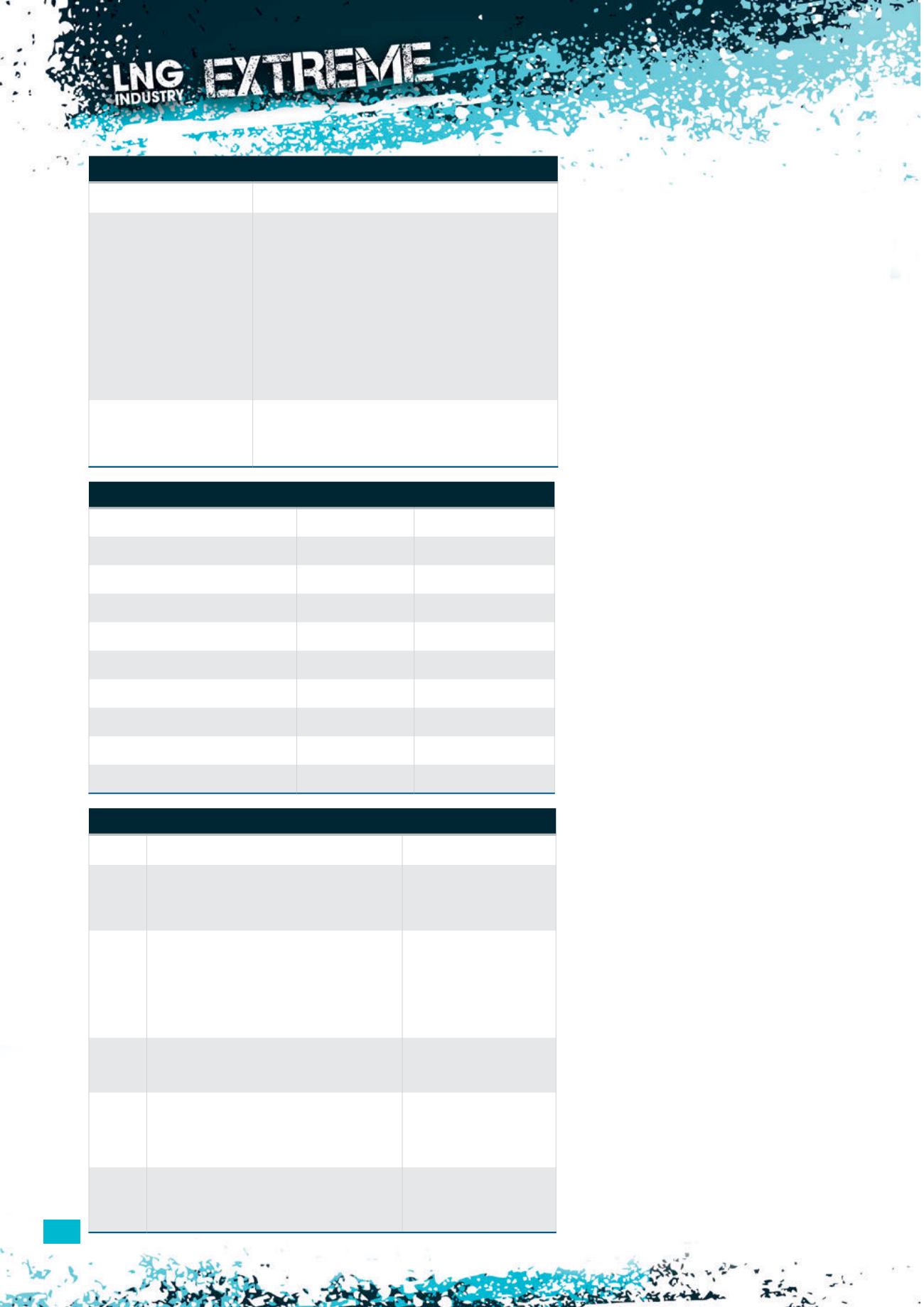
48
Another LNG carrier accident statistic
shows that 10 out of every 158 accidents are
caused by fire and explosions (Table 2).
2
Fire class and
characteristics
Any onboard fire is identified based
on its fire class
3
(Table 3) and it is
important to consider LNG/natural
gas fire characteristics
4
to gain a better
understanding of the cause of the fire and
the selection of a suitable fire fighting
method.
Either a fixed or a portable fire fighting
systemwill be selected, based on the class
of fire.
The offshore fire resulting from a
hydrocarbon escape is graded as Class B.
This article will look at the different types of
hydrocarbon fires.
Pool and running liquid fires
Pool fire is defined as a turbulent diffusion
fire burning above a horizontal pool
of vaporising hydrocarbon fuel under
conditions where the fuel has zero, or low,
initial momentum.
A running liquid fire is broadly similar to
a pool fire in that it relies on thermal
feedback from the flame for its fuel vapour
supply, but the liquid can be on surfaces of
any orientation and in motion.
Jet fires
A jet fire is a turbulent diffusion flame
resulting from the combustion of a fuel
continuously released with significant
momentum in a particular range of
directions.
Cloud fires and fireballs
A cloud fire is a transient fire resulting from
the ignition of a cloud of gas or vapour and
not subject to significant flame acceleration
via the effects of turbulence.
A fireball is a rapid turbulent
combustion of fuel as an expanding, and
usually rising, radiant ball of fire.
Fire protection analysis
It is vital that facilities, structures and
personnel on board are protected in the
case of a fire. The protection criteria and
methods will be discussed in this section of
the article.
Thermal radiation protection
The American Institute of Chemical Engineers
Center for Chemical Process Safety (CCPS)
5
Table 2.
Types and frequency of accidents
Accident category
Number of accidents Frequency (per ship year)
Collision
19
6.7 x 10
-3
Grounding
8
2.8 x 10
-3
Contact
8
2.8 x 10
-3
Fire and explosion
10
3.5 x 10
-3
Equipment and machinery failure
55
1.9 x 10
-2
Heavy weather
9
3.2 x 10
-3
Events while loading/unloading cargo 22
7.8 x 10
-3
Failure of cargo containment system 27
9.5 x 10
-3
Total
158
5.6 x 10
-3
Table 3.
Different classes of fire
Fire class Definition
Location on board
Class A Class A fire includes solid materials that are
usually organic in nature and produce glowing
embers, such as wood, textiles, curtains,
furniture and plastics
Accommodation and
lay-down area
Class B Class B fire includes all flammable liquids
and solids, which can be subdivided into:
non-miscible (non-polar) with water (i.e. petrol
oils, solvents, paints and waxes); polar liquid
fires (hydrophilic/miscible) with water (i.e.
alcohol, methanol, acetone, propanol, etc.) –
sometimes known as polar liquids
Marine diesel oil (MDO)
storage tank, MDO service
tank, overflow tank in the
engine room, and the paint
room
Class C Class C fire inlcudes natural gas from the mains,
as well as LPG, such as butane and propane, etc.
Topside
Class D Class D fire consists of combustible metals –
especially alkali metals, such as lithium and
potassium, and alkaline earth metals, such as
magnesium, etc.
N/A
Class F Class F fire involves unsaturated cooking oils
(no less than 360°C) in well-insulated cooking
appliances located in commercial kitchens
Galley
Table 1.
Platform accidents and investigation results
Platform accident
Investigation results
Piper Alpha platform
explosion and fire
1.
Most of the emergency systems of the platform,
including the fire water system, failed to come into
operation
2.
Serious deficiencies in the working of the permit to
work system
3.
Procedure was not adhered to and unsafe practices
were followed in a number of situations
4.
Management failed to ensure that necessary
training was provided and carried out insufficient
assessments of major hazard risks. In effect, while
safety policies and procedures were established,
they were not adequately implemented
Mumbai High North platform
collision and gas leak fire and
explosion
The fire significantly affected rescue, with only two out
of the eight complex lifeboats able to be launched,
and only one out of 10 life rafts. Similarly, only half of
New York City’s rescue craft could be launched


